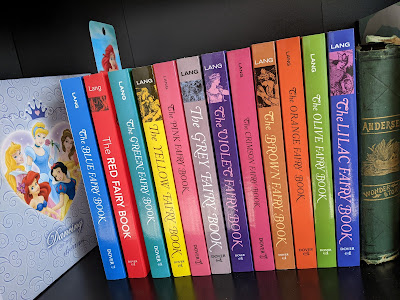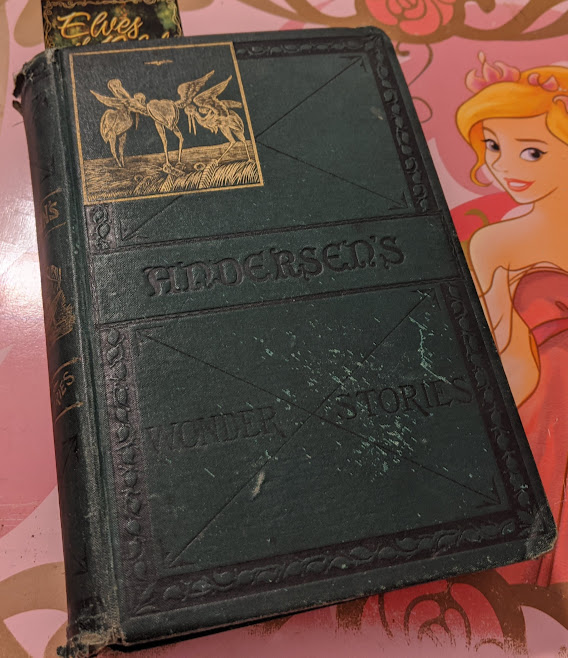Though it feels like fairy tales have been around forever, the popular versions that we know today have actually only been circulating in English-speaking countries for a little over a hundred years. Much of this is thanks to a name that we rarely hear associated with fairy tales, Andrew Lang. Lang didn't write any fairy tales himself, but he was one of the first people to translate stories from the Brothers Grimm, Hans Christian Andersen, Charles Perrault, Madame d"Aulnoy, and others into English to introduce them to a wider audience of fantasy lovers with the Fairy Books of Many Colors, a 12-volume encyclopedia of fairy tales from all over the world. Lang was a scholar who published a number of periodicals, poems, and fiction, but he was most famous for annotating these stories that were translated by his wife and illustrated with beautiful ink drawings by H.J. Ford. Thanks to the magic of the internet, I was able to acquire a full set of the Fairy Books at a relatively decent price through Dover Publications on Amazon.

What separates these books from single-author anthologies like the Brothers Grimm or Hans Christian Andersen is that the stories in each color book are strategically selected from around the world to create the most entertaining collection possible to fill approximately 350 pages of content each. I've read full anthologies of the Brothers Grimm and Hans Christian Andersen (as pictured on my shelf), and both of these contain quality fantasy stories about magic and princesses mixed in with a large number of duds about talking animals or weird anecdotes that end abruptly and don't quite fit with the rest. Though Andrew Lang's books contain many stories I was already familiar with, they have an equal mix of obscure fairy tales from other cultures that have the same level of fantasy and adventure as the popular ones. Another thing I love about his books is that almost every story contains a beautiful princess. What's great about the Dover editions in particular is that they contain each and every one of H.J. Ford's beautiful illustrations that really pull the reader into the world of these stories when the writing can get too dry. Each book contains roughly one hundred drawings that set the tone for each story.
Most of the commonly known fairy tales are in the first few books--
The Blue Fairy Book,
The Red Fairy Book, and
The Green Fairy Book, so continuing down the line reveals more and more lesser-known stories with similar themes. Even the stories I was already familiar with had something new to offer from these early adaptations. For instance, the Fairy Books' version of
"Jack and the Beanstalk" reveals that the treasures Jack found in the giant's castle at the top of the beanstalk rightfully belonged to his family and were stolen from his parents before he was born. In this version of
"The Twelve Dancing Princesses," it is revealed that the princesses' dance partners in their secret underground world were other princes who tried to figure out what they were doing each night and fell under their spell. Cursing their dance partners instead of the princesses themselves might be better fodder for a full-length adaptation of this story than
some of the ones I've read. There's also a version of
"Goldilocks and the Three Bears" that features an old woman instead of Goldilocks and an unrelated story
about a princess named Goldilocks.
I've only completed the blue, red, and green books so far and am working on the yellow one. I've already learned a lot about the evolution of fairy tales. These books taught me just how many different versions have spread among various cultures of the same or similar stories. As expected, the books contain several different versions of
"Cinderella," the most retold story of all time, but there are other stories and themes that are also repeated often. For instance, a popular story with many adaptations involves three brothers who leave home to become adults and support their families. In these stories, the youngest and most ostracized brother is always the one who finds the most success and ends up winning a beautiful princess. They also need to perform three tasks every time. The rule of threes is also popular in fairy tales. Characters going on quests must almost always perform three tasks or repeat the same three actions every time before something different happens. This rule was the reason
Disney decided to give Aladdin three wishes even though the genies from
the original fairy tale granted unlimited wishes. Princesses are typically treated as
prizes to be won in older fairy tales, and the amount of agency they have changes depending on the story. There's also a recurring theme of
animal transformations. In many stories, the protagonist will encounter a talking animal who gives them advice for their quest. If they are diligent in following the advice, the animal usually transforms into a beautiful prince or princess who marries the main character at the end.

Reading the original translations also reveals some of the
less pleasant parts of history that modern media often tries to cover up or avoid. For instance, some of the stories reference slavery, and there is always a strong focus on beauty correlating to virtue, something that was overplayed in
The School for Good and Evil, a modern take on older fairy tales. Beautiful characters are always kind, whereas cruel ones are always ugly. A particularly outdated story that would never be accepted in today's world is
"One Eye, Two Eyes, and Three Eyes," in which the only sister who passes as "normal" because she has two eyes is ostracized by the rest of her family, who thinks they are special for having one and three eyes, respectively, and torment her in a cruel fashion until she manages to find a way out. In today's society (and the real world in general), it would be the ones who are different who would get ostracized and need to find their own happiness instead of punishing people who already fit in. One of the only stories I read so far in these books with a prince and princess who are considered conventionally ugly but still virtuous is
"The Golden Branch," but even that one ends with the fairies giving them the gift of beauty as a reward for their struggles.
The one story that I was the most disappointed not to find in any of the twelve Fairy Books is
"The Little Mermaid," my favorite fairy tale from Hans Christian Andersen. Fortunately, I was gifted a few years ago with a rare first-edition anthology of Hans Christian Andersen's fairy tales which does contain that story, so I keep it on my shelf next to the Fairy Books of Many Colors. Speaking of "The Little Mermaid," there was a
recent leak of the upcoming trailer for
the latest Disney adaptation of the film. The full trailer is rumored to go public tomorrow or within the coming week, so I will be here to provide coverage when it does. It's interesting to see just how much these stories have evolved since the original translations were leaked in the late 19th century. Do you know any obscure fairy tales that have become obsolete or lost to time? Let me know in the comments!



















Comments
The issue of beauty, at least for me, is not so much that good people are beautiful, but that in ancient tales "beautiful" was blonde hair, white skin, and blue eyes.
Dark tales of princesses mmmm...I remember an indigenous tale of a princess who got engaged to a handsome prince from a mysterious tribe who rescued her in the forest from a wolf, then she discovered that at night this tribe transformed into snake people that terrorized other tribes and her fiancé planned to convert her through the wedding dress that he gave her, which was a cursed dress.
The princess ends up killing her fiancé when she wanted to force her to wear the dress and the whole tribe chases her until the sun rises, then they burn and die. Then she marries a brave warrior from her own tribe.
A lot of old fairy tales end with characters suffering horrible deaths.